Describe Three Elements or Principles of Art Found in This Art Pie
Have yous ever wondered what the building blocks of a painting are? Whether y'all look at a Renaissance masterpiece similar the Mona Lisa (c. 1503) or an Impressionist en Plein air piece by Claude Monet, you will be confronted with a visual composition of a scene or person, which is really a combination of artistic elements and principles. In this commodity, we will explicate what these elements of art and principles of design are.
Table of Contents
- 1 The Fundamentals: What Are the Principles of Fine art?
- two The Seven Elements of Art
- 2.1 Color
- 2.ii Value
- 2.3 Line
- 2.4 Form
- 2.5 Shape
- ii.half-dozen Infinite
- 2.7 Texture
- 3 The Principles of Fine art
- 3.1 Residuum
- 3.ii Dissimilarity and Emphasis
- iii.three Movement and Rhythm
- 3.4 Variety
- 3.5 Unity and Harmony
- three.six Design and Repetition
- 3.7 Proportion
- 3.8 Scale
- 4 Bringing It All Together
- five Ofttimes Asked Questions
- 5.ane What Are the Principles of Blueprint?
- 5.2 What Is the Difference Between the Elements of Fine art and the Principles of Design?
- 5.3 What Are the Seven Principles of Art?
The Fundamentals: What Are the Principles of Art?
According to the Merriam-Webster Online Dictionary, the word "principle" ways: "a comprehensive and cardinal police, doctrine, or assumption", including "a dominion or code of carry". Therefore, a principle refers to the central aspects or rules of something.
In the visual arts, information technology would refer to its fundamentals or rules, which leads us to the question, what are the fundamentals of visual arts, or what are the principles of art? A set of rules that artists follow that informs the composition? Often, these are also criteria used to analyze artworks.
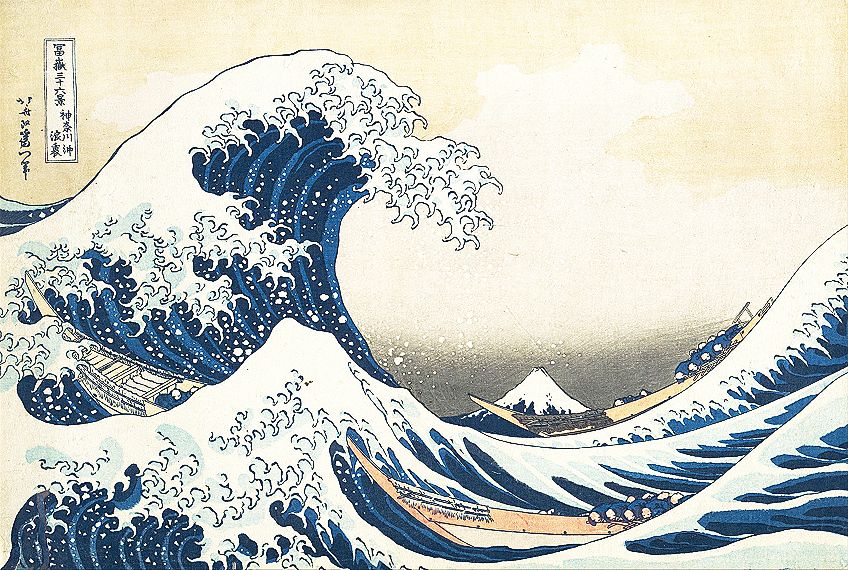 The Great Wave off Kanagawa (between 1830 and 1832) by Katsushika Hokusai, located in the Metropolitan Museum of Art in New York City, Usa; Katsushika Hokusai, Public domain, via Wikimedia Commons
The Great Wave off Kanagawa (between 1830 and 1832) by Katsushika Hokusai, located in the Metropolitan Museum of Art in New York City, Usa; Katsushika Hokusai, Public domain, via Wikimedia Commons
It is of import to note before we explore these fine art principles, that these should not be dislocated with the elements of art, which are described as the "visual tools" that compose an artwork. These besides become criteria by which artworks are analyzed. Nosotros volition also look at these in more detail below.
Furthermore, you may come beyond various art sources that use these two terms (elements and principles) interchangeably.
Therefore keep it in mind while y'all do fine art reading and research, and remember their differences and functions inside the visual arts. We will aim to provide the differences between the two while also intentionally applying the terms interchangeably.
The Seven Elements of Art
| Fine art Element | Characteristics | Artwork Examples |
| Color | We see color every bit reflected lite that bounces off objects effectually us. Colour has three characteristics: hue, value, and intensity. There are main, secondary, and third colors on the color wheel. | Composition VII (1913) past Wassily Kandinsky |
| Form | Form is three-dimensional with book, which includes height, depth, and width. It includes shapes similar cubes, spheres, and cones. Forms tin either exist organic or geometric. | David (1501 to 1504) by Michelangelo Galatea of the Spheres (1952) past Salvador Dalí |
| Line | At that place are vertical, horizontal, and diagonal lines. Lines tin exist thick, thin, curved, direct, or patterned to emphasize a shape. | The Starry Night (1889) by Vincent van Gogh Composition with Ruby, Yellow, and Blue (1929) past Piet Mondrian |
| Value | Value is the lightness or darkness of a color. As well referred to every bit "luminosity". | Melancholy I (1514) by Albrecht Dürer |
| Shape | Shape is two-dimensional and has width and length. It includes circles, squares, rectangles, or pyramids. Shapes tin be organic or geometric. | Three Musicians (1921) by Pablo Picasso Black Square (1915) past Kazimir Malevich |
| Space | Space is the distance between or around objects. Space can exist positive or negative, open or closed. Space also portrays perspective and depth. | The Hunters in the Snow (1565) by Pieter Brueghel the Elder Chair (Cannes) (1961) by Pablo Picasso |
| Texture | Texture refers to the "surface quality" of an artwork. Texture tin either exist felt in existent life or portrayed through the illusion of it by using pigment or other media. | Penitent Magdalene (1453 to 1455) by Donatello The Arnolfini Portrait (1434) by Jan van Eyck |
Let united states start with the seven elements of art. As we explained above, these are the "visual tools" used to compose a painting. Think of them every bit the colors on your palette, as each one offers a unique quality, which gives your composition its shape, so to say.
There are 7 elements of art, namely, colour, course, line, value, shape, space, and texture. These are important to empathize when viewing a painting, or creating a painting. Nosotros will become through each of these in more than detail below.
Colour
Color is an important chemical element in visual arts considering it creates significant furnishings, not only visually, but psychologically too. At that place is a science to color and many great artists have celebrated the inherent magic of color besides, only recall about Wassily Kandinsky or Piet Mondrian, to name a few.
Color offers a broad spectrum, then let usa first beginning with how it works with light because this will provide some context when nosotros next look at an artwork. Color reaches our eyes in the grade of reflected light, which "bounces" off the objects around usa.
In that location are 3 chief aspects or elements related to color, namely, hue, value, and intensity (this is besides sometimes referred to every bit saturation or blush). Hue relates to the color of the color, and then to say, for example, the hue is blue, light-green, or purple.
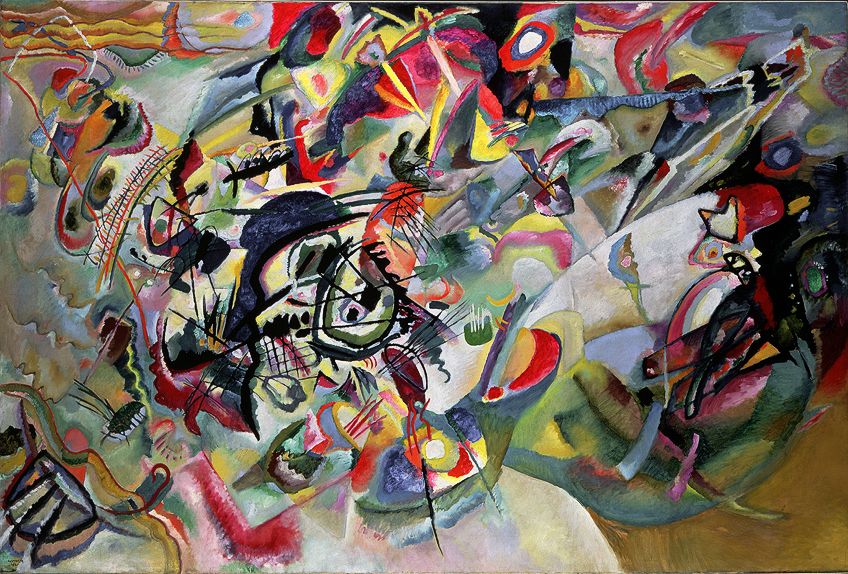 Composition VII(1913) by Wassily Kandinsky, located in the Tretyakov Gallery in Moscow, Russia; Wassily Kandinsky, Public domain, via Wikimedia Eatables
Composition VII(1913) by Wassily Kandinsky, located in the Tretyakov Gallery in Moscow, Russia; Wassily Kandinsky, Public domain, via Wikimedia Eatables
Value relates to the "lightness" of colour; its lightness like white or its darkness similar blackness, and all the other colors in between. If a white is added to a color it becomes known equally a "tint" and the value of information technology becomes lighter, and conversely, if blackness is added to a color it becomes a "shade" and the value becomes darker.
Intensity relates to how bright or dull a color appears. This can often be confused with value too, but the distinguishing factor between the two is that intensity otherwise referred to every bit saturation, refers to the brightness of the colour. Nevertheless, if the value of the colour is lighter the intensity of the color will also decrease and vice versa.
The color wheel is another important aspect and includes the primary, secondary, and third colors. The chief colors consist of red, bluish, and yellowish and the secondary colors consist of purple, orange, and green.
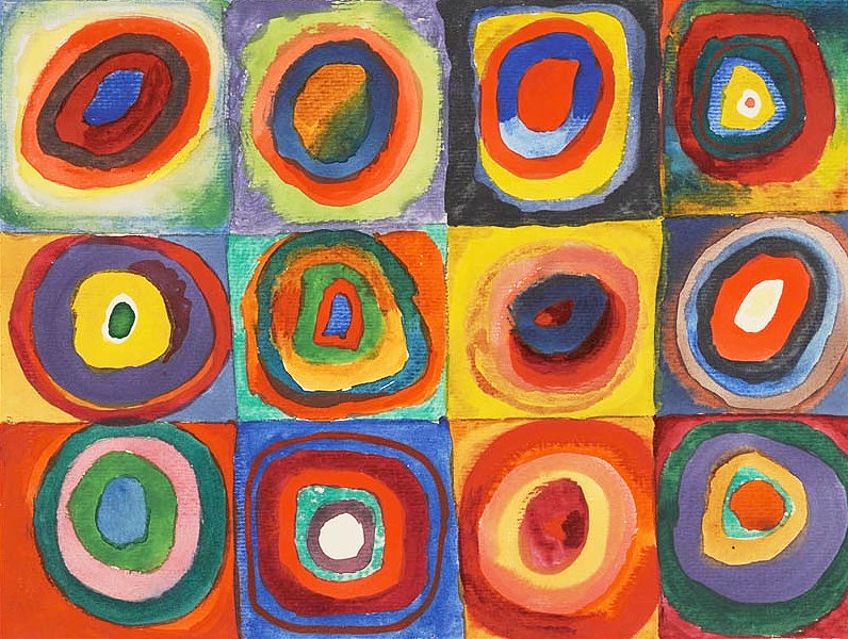 Color Study: Squares with Concentric Circles (1913) by Wassily Kandinsky, located in the Stadtische Galerie in Munich, Frg; Wassily Kandinsky, Public domain, via Wikimedia Eatables
Color Study: Squares with Concentric Circles (1913) by Wassily Kandinsky, located in the Stadtische Galerie in Munich, Frg; Wassily Kandinsky, Public domain, via Wikimedia Eatables
The colors betwixt primary and secondary colors are referred to equally "intermediary" colors, namely, yellow-greenish, yellowish-orange, reddish-orange, red-purple / violet, blue-greenish, and blue-purple/violet. It is important to notation here that these intermediary colors are also sometimes chosen tertiary colors.
Yet, several online sources state that tertiary colors are, in fact, the combination of two secondary colors and not the intermediary colors, which are a combination of principal and secondary colors, evident on the colour wheel.
Value
Value is another element of art closely continued to colour. As we mentioned above, value refers to the lightness and darkness of any colour. Some other term that relates to value is too "luminosity". For a amend agreement of how value actually works, you can view an image on a grayscale, in which, there will be lighter and darker areas.
This gives an indication of the lighter and darker areas of color. Another term utilized here is "contrast", which refers to the difference betwixt the lighter and darker areas.
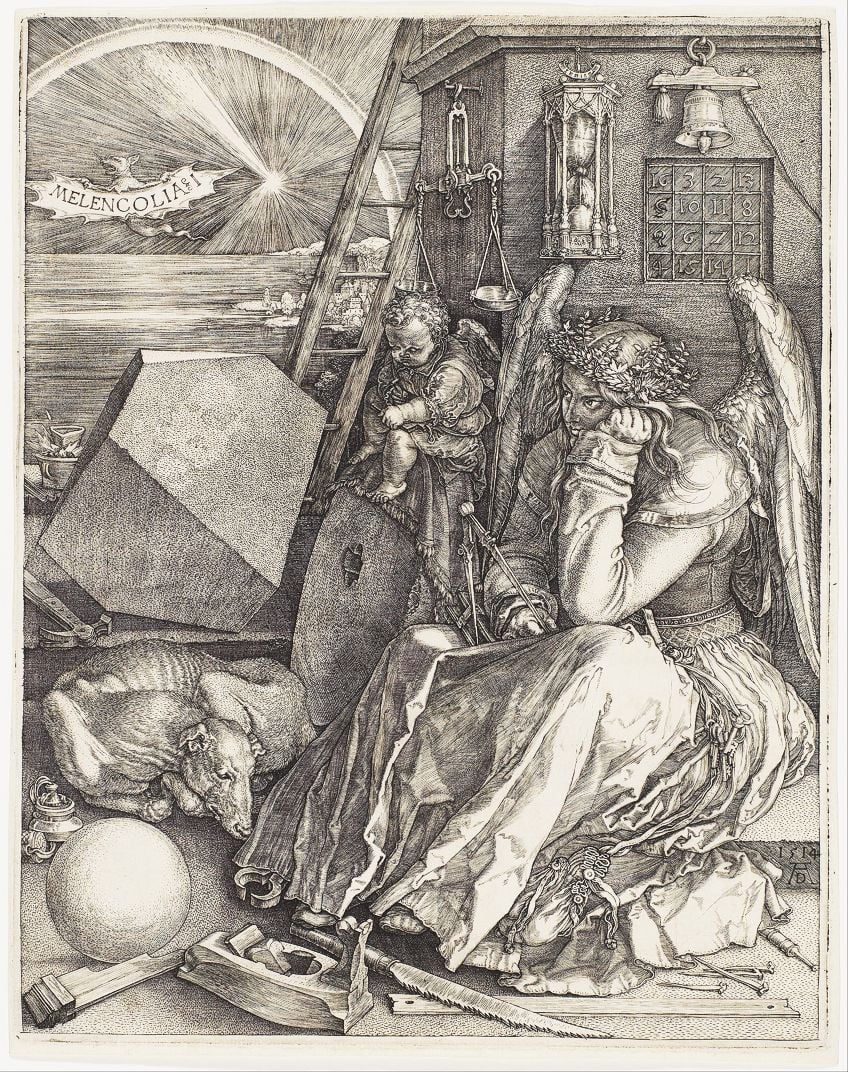 Melencolia I(1514) by Albrecht Dürer, located in the Minneapolis Establish of Fine art in Minneapolis, United States; Albrecht Dürer, Public domain, via Wikimedia Commons
Melencolia I(1514) by Albrecht Dürer, located in the Minneapolis Establish of Fine art in Minneapolis, United States; Albrecht Dürer, Public domain, via Wikimedia Commons
Line
Line in visual art is considered ane of the more important elements and, by paraphrasing, information technology is typically described as a mark that moves in space between 2 points. There are unlike types of lines, namely, vertical, horizontal, and diagonal.
Lines tin likewise appear thick, thin, curved, direct, short, long, or patterned, which creates varying effects in a composition.
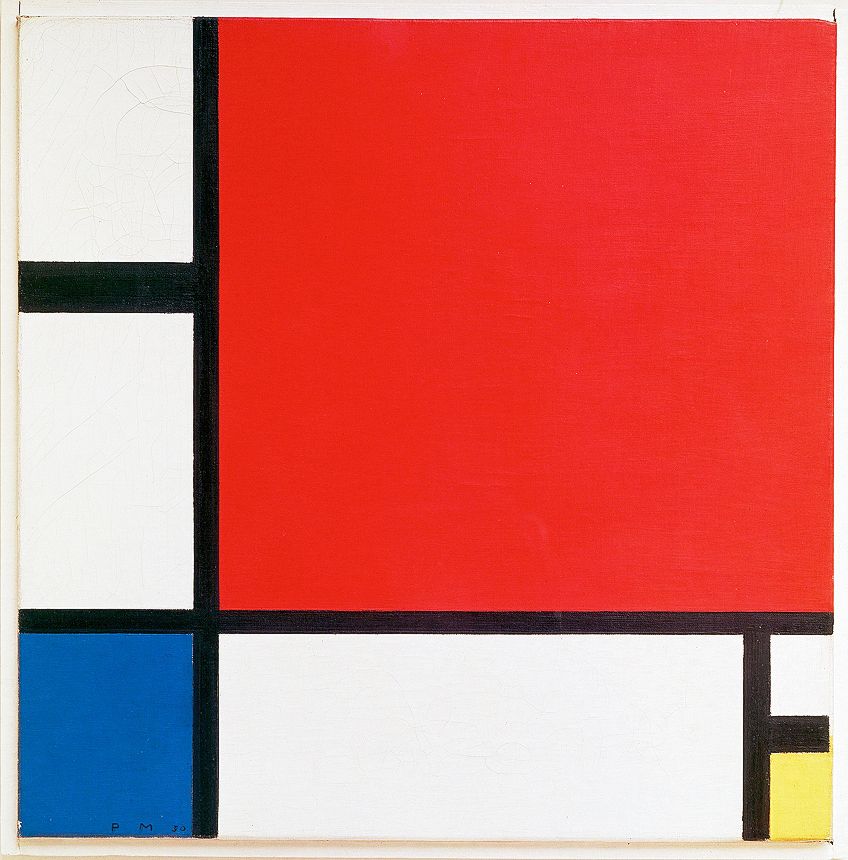 Composition II in Blood-red, Bluish, and Yellow(1930) by Piet Mondrian, located in the Kunsthaus Zürich in Zürich, Switzerland; Piet Mondrian, Public domain, via Wikimedia Commons
Composition II in Blood-red, Bluish, and Yellow(1930) by Piet Mondrian, located in the Kunsthaus Zürich in Zürich, Switzerland; Piet Mondrian, Public domain, via Wikimedia Commons
For example, movement, depth, shading, perspective, as well every bit emphasizing a shape or "contour" can exist created with line. This is visible if we look at examples of artists who applied thick nighttime outlines to shapes from the Expressionism art movement.
Some notable artists who made use of thick lines are Edvard Munch and Vincent van Gogh.
Form
Form as an art chemical element refers to the three-dimensionality of an object, information technology is usually described as having volume, which comprises width, acme, and depth. Information technology is also represented through other elements like color variations and lines to indicate a contour or outline.
Furthermore, in visual art, nosotros are by and large looking at a ii-dimensional surface, therefore a form creates the "illusion" of iii-dimensionality.
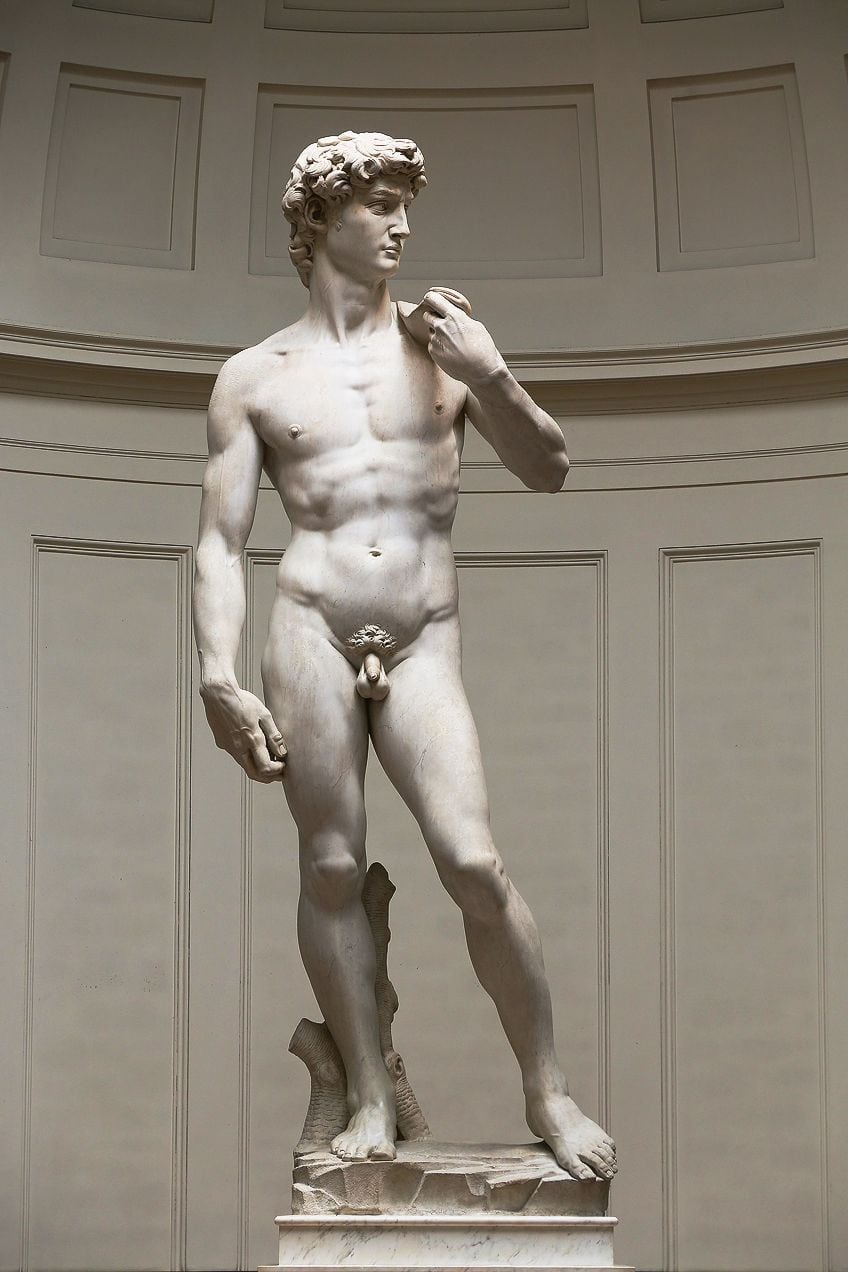 David(1501 – 1504) by Michelangelo, located in the Galleria dell' Accademia in Florence, Italy; Michelangelo, CC Past-SA 3.0, via Wikimedia Commons
David(1501 – 1504) by Michelangelo, located in the Galleria dell' Accademia in Florence, Italy; Michelangelo, CC Past-SA 3.0, via Wikimedia Commons
In that location are unlike types of forms, namely, organic, and geometric forms. Organic forms tin can originate from nature and are more than random and asymmetrical; geometric forms are described equally "mathematical", namely, the cylinder, cube, cone, or pyramid, and sphere.
Shape
Shape relates closely to form, only the main difference is that a shape refers to two-dimensionality. It is often described as "flat", with only length and width, and does not have the same appearance of volume that a form has. Similarly, shapes can too be grouped under the categories, geometric or organic.
Shape gives the contour of an object, which essentially comprises lines.
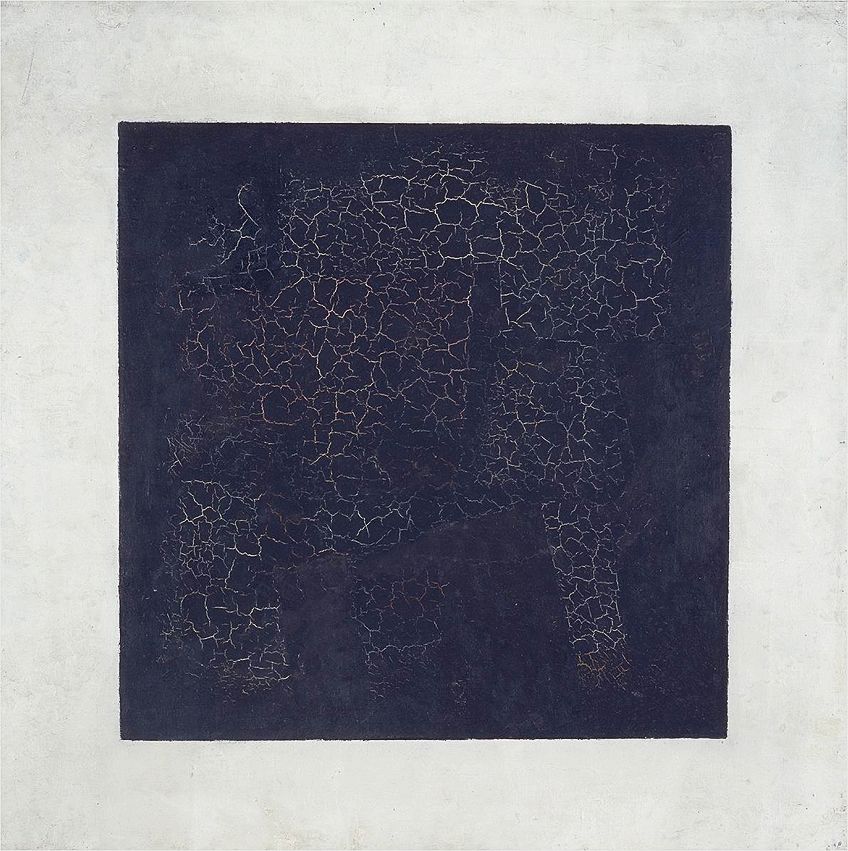 Black Foursquare(1915) by Kazimir Malevich, located in the Tretyakov Gallery in Moscow, Russia; Kazimir Malevich , Public domain, via Wikimedia Commons
Black Foursquare(1915) by Kazimir Malevich, located in the Tretyakov Gallery in Moscow, Russia; Kazimir Malevich , Public domain, via Wikimedia Commons
There are different types of shapes, namely, circle, square, triangle, rectangle, oval, and others. A fun fact near these shapes is when they plow into forms, for example, a circle becomes a sphere, a triangle becomes a cone, and a foursquare becomes a cube, so forth.
Some other artistic technique that conveys shapes is using positive and negative space.
Space
Infinite is often described as the "distance" either "within", "around", or "between" the compositional space, which can be a canvas, a sculptural space, or any other course of art. There are also unlike types of space, namely, positive, negative, and open and closed space.
Positive space is the object or subject itself in artwork, for case, if a pair of scissors is drawn, the positive space would exist the pair of pair of scissors. The negative space is the space around the discipline, in this case, the pair of pair of scissors and the surface area in the loops of the pair of scissors would found the negative space.
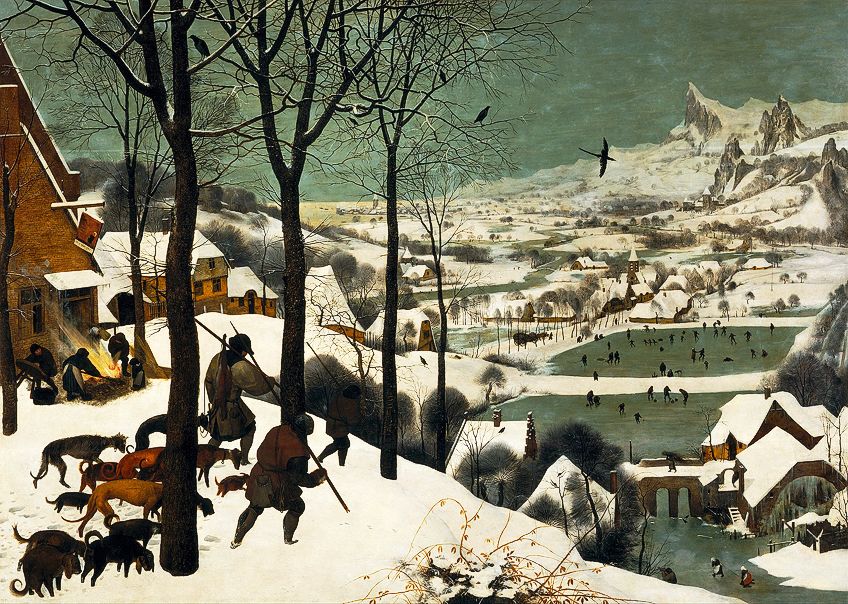 The Hunters in the Snowfall(1565) by Pieter Brueghel the Elder, located in the Kunsthistorisches Museum in Vienna, Austria; Pieter Brueghel the Elder, Public domain, via Wikimedia Commons
The Hunters in the Snowfall(1565) by Pieter Brueghel the Elder, located in the Kunsthistorisches Museum in Vienna, Austria; Pieter Brueghel the Elder, Public domain, via Wikimedia Commons
This is like open and closed spaces, where the object would be in the closed infinite and the open up space would be effectually it. Space is besides conveyed when a composition is separated into parts, especially when you analyze a painting and describe the subject matter in terms of its spatial arrangements, which can either be in the foreground, middle ground, or background, upper, lower, left, or right.
Additionally, infinite is conveyed in fine art through variations of depth, otherwise referred to as perspective, and proportion otherwise referred to by size.
Texture
Texture is all near feeling, and there are typically two primary ways it is conveyed in visual art, namely, in real life, or three-dimensional space, for example, sculptures or the "tactile" feeling of paint on a canvas, for example through the "impasto" technique, where the paint is physically textured on the sail.
The other way that texture can be shown is through suggestion or the "illusion" of texture on a two-dimensional infinite.
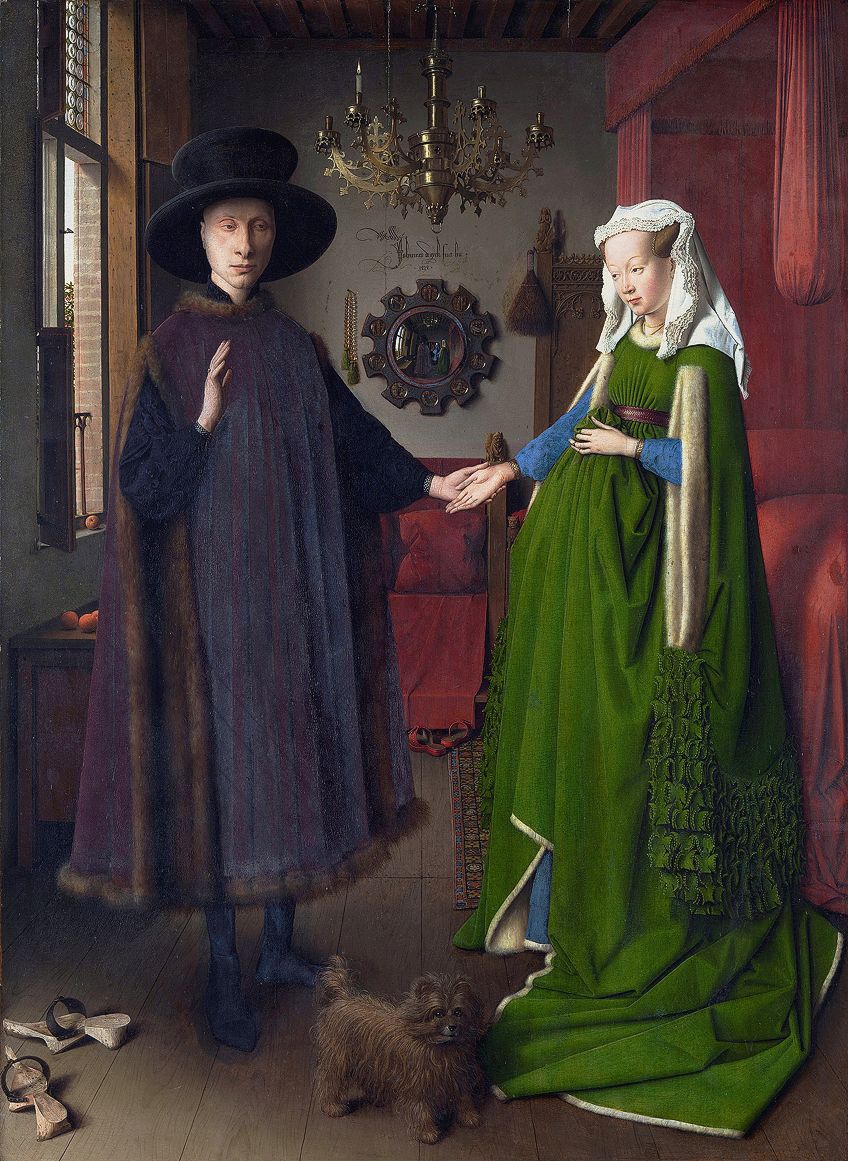 The Arnolfini Portrait (1434) by January van Eyck, located in the National Gallery in London, United Kingdom;Jan van Eyck, Public domain, via Wikimedia Eatables
The Arnolfini Portrait (1434) by January van Eyck, located in the National Gallery in London, United Kingdom;Jan van Eyck, Public domain, via Wikimedia Eatables
This is washed by utilizing various techniques with paint, pencil, or pen on a sail or piece of newspaper. Both refer to what is described every bit the "surface quality" of an artwork. Texture gives character to an fine art form and creates psychological furnishings for usa, the viewers when we engage with information technology.
The Principles of Art
| Art Principle | Characteristics | Artwork Example |
| Balance | Balance can be symmetrical, asymmetrical, or radial. | The Last Supper (c. 1495 to 1498) by Leonardo da Vinci |
| Contrast and Accent | Dissimilarity is created by placing different art elements together to add emphasis, this can also be through calorie-free/night effects. | The Calling of Saint Matthew (1599 to 1600) by Caravaggio |
| Movement and Rhythm | Movement creates activity or dynamic effects to lead the viewers' eyes to the focal indicate. Rhythm is created through repeated elements and this creates move. | The Slap-up Moving ridge (1830 to 1832) past Katsushika Hokusai The Scream (1893) by Edvard Munch |
| Multifariousness | Variety creates an ongoing interest in a composition, it is the utilization of various fine art elements similar color, line, or texture. | Haystacks (1891) by Claude Monet |
| Unity and Harmony | Unity refers to the abyss of the composition and all the elements working together to create a unified whole. Harmony is similar to unity but it can also hateful the reverse of variety. | A Sunday on La Grande Jatte (1884) by Georges Seurat |
| Pattern and Repetition | Art elements are placed in patterned arrangements to create an effect. | Golconda (1953) past René Magritte |
| Proportion | How an object's parts relate to each other in size. | The Vitruvian Man (1490) by Leonardo da Vinci |
| Scale | The size of the bailiwick/object compared to the rest of the objects in the composition. | Cristina's World (1948) by Andrew Wyeth |
We now have an understanding of the elements of art, which nosotros described as almost existence like the colors on your palette. The question, "what are the principles of pattern?" directly relates to the elements of art, and as nosotros get through the principles of design in art, nosotros will meet how these determine the artwork's overall issue. These could well-nigh be seen in your paintbrushes, so to say; each paintbrush will be unique, providing a specific part to bring the composition together.
There are several principles of blueprint in art, some sources explore information technology as 10, while others see it every bit vi or vii. Some tin also exist grouped together as the concepts are similar, but it should be noted not to be dislocated past the close similarities of some.
Nosotros will outline eight fine art principles below, with some grouped together, and a brief explanation of each. These are, namely, rest, dissimilarity/emphasis, movement, rhythm, variety, unity/harmony, pattern/repetition, proportion, and calibration.
We have separate articles for each principle of art:
- Movement in Art
- Emphasis in Art
- Unity in Fine art
- Rhythm in Art
- Texture in Art
- Proportion in Art
- Balance in Art
- Harmony in Art
Balance
Balance is nigh the compositional "weight of visual elements", whether these are applied in such a manner that provides the consequence of even distribution. In that location can be symmetrical, asymmetrical, and radial balance.
Symmetrical refers to both sides beingness the aforementioned, or "mirroring" one another. Asymmetrical refers to both sides having different subject affair or objects, only there is a balanced effect, nonetheless. Radial balance means that the visual elements are "equally" placed around a centralized "indicate" in the composition.
 The Concluding Supper(1495 – 1498) past Leonardo da Vinci, located in the Santa Maria delle Grazie in Milan, Italy; Leonardo da Vinci, Public domain, via Wikimedia Commons
The Concluding Supper(1495 – 1498) past Leonardo da Vinci, located in the Santa Maria delle Grazie in Milan, Italy; Leonardo da Vinci, Public domain, via Wikimedia Commons
Contrast and Emphasis
Dissimilarity refers to the placements of different elements in a limerick, for example, colour, space, shape, or others. By utilizing contrast strategically, information technology will convey a sense of emphasis, or otherwise stated; it will emphasize a certain area in the composition.
Accent refers to a "focal point" in a composition.
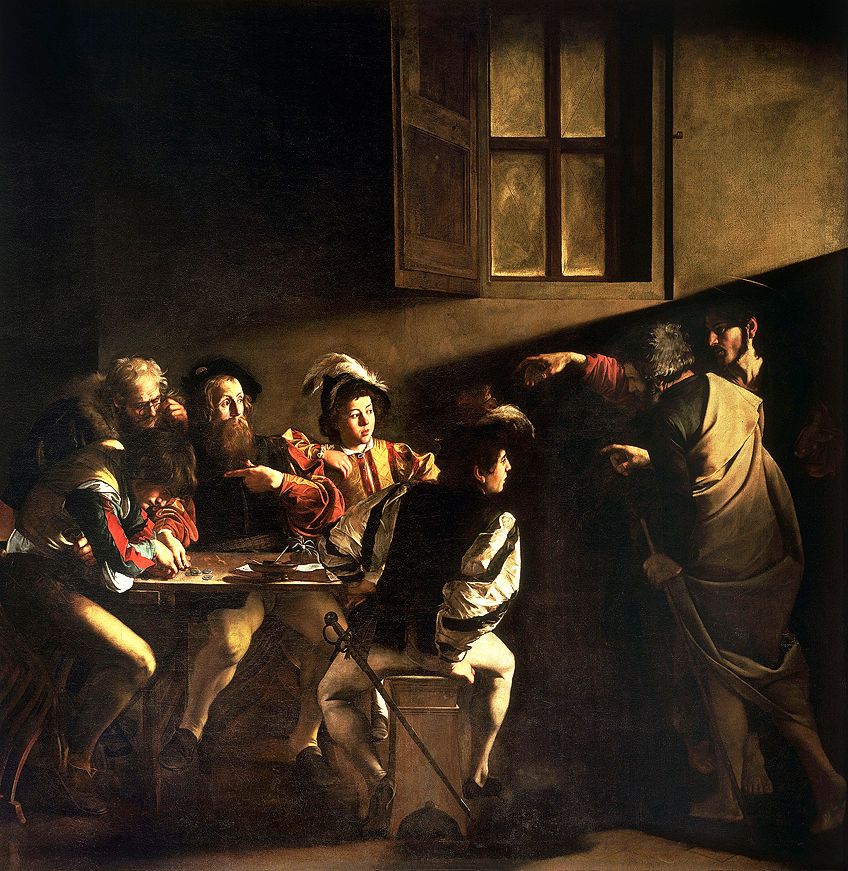 The Calling of Saint Matthew (1599 – 1600) by Caravaggio, located in Contarelli Chapel in Rome, Italian republic;Caravaggio , Public domain, via Wikimedia Eatables
The Calling of Saint Matthew (1599 – 1600) by Caravaggio, located in Contarelli Chapel in Rome, Italian republic;Caravaggio , Public domain, via Wikimedia Eatables
Movement and Rhythm
Movement is all most leading the middle to the focal indicate or central field of study, or simply around the entirety of the limerick. It is achieved by arranging and applying various elements in such a way that creates a sense of dynamism.
Some of the art elements that create motion can be the placement of different lines.
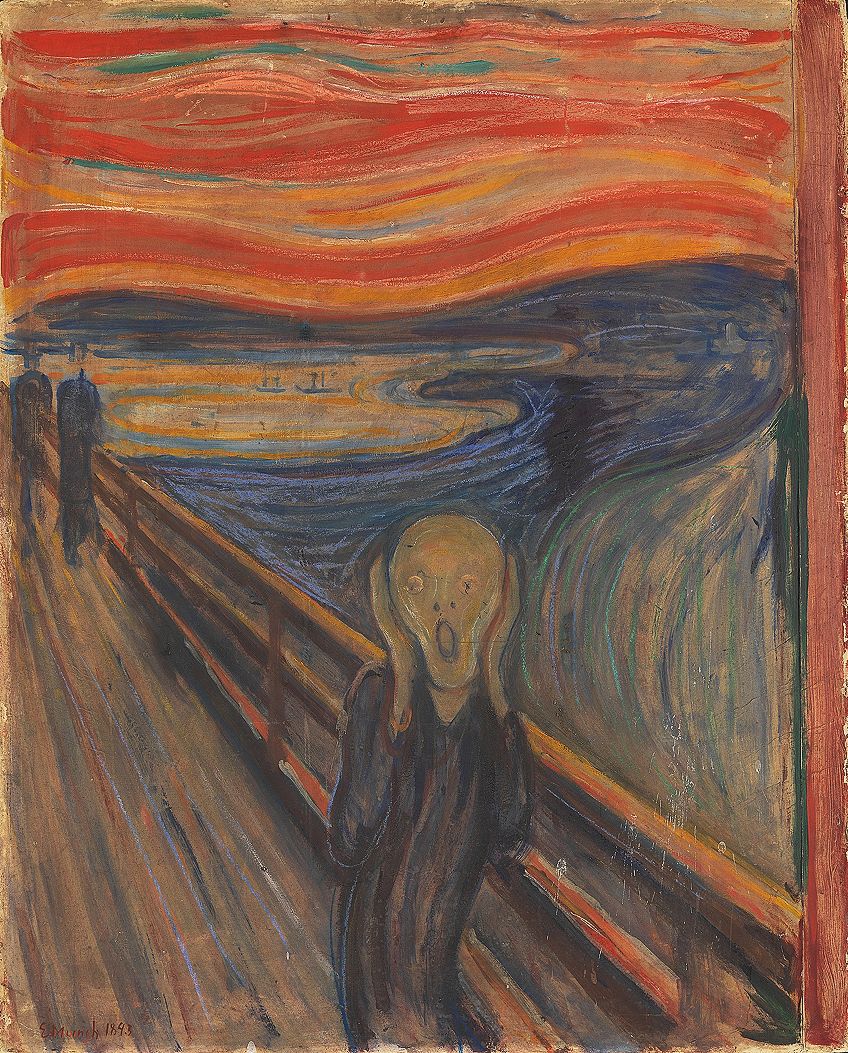 The Scream(1893) by Edvard Munch, located in the National Museum of Art, Architecture, and Blueprint in Oslo, Norway; Edvard Munch, Public domain, via Wikimedia Commons
The Scream(1893) by Edvard Munch, located in the National Museum of Art, Architecture, and Blueprint in Oslo, Norway; Edvard Munch, Public domain, via Wikimedia Commons
These lines are commonly diagonal or curved, which add to the color, infinite, shape, and various other elements. Rhythm is mainly created through repeating elements or placing them in patterned arrangements.
This ultimately creates a sense of motility in a composition.
Diversity
Variety is basically about dissimilar elements in a composition that gives information technology its uniqueness. It provides a continuing contrast, or some sources describe "chaos", which engages the viewer and maintains a level of interest and awe for the limerick; it evokes emotion and expression.
Chiefly, diversity besides needs to be utilized in a balanced manner so as not to create too much of information technology that information technology detracts from the composition's dazzler or narrative, or as well piddling that information technology creates a sense of boredom or confusion in meaning.
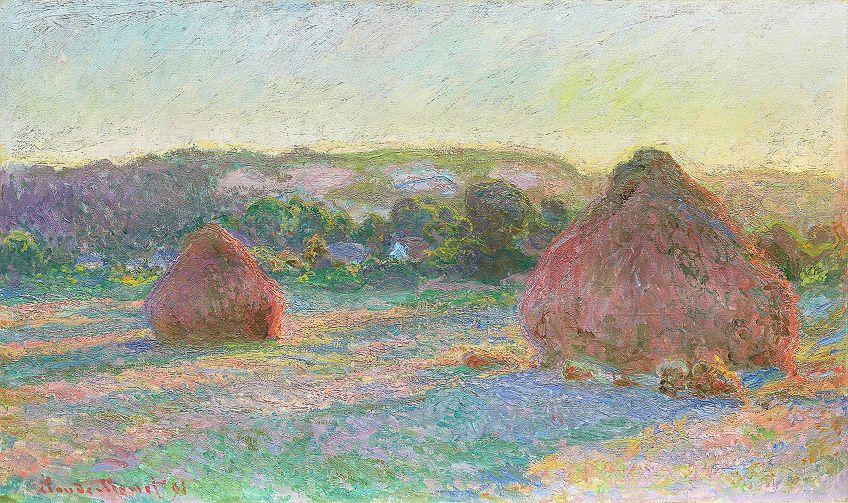 Stacks of Wheat (End of Summer)(between 1891 and 1897) by Claude Monet, located in the Art Institute of Chicago in Chicago, The states;Claude Monet, Public domain, via Wikimedia Commons
Stacks of Wheat (End of Summer)(between 1891 and 1897) by Claude Monet, located in the Art Institute of Chicago in Chicago, The states;Claude Monet, Public domain, via Wikimedia Commons
Unity and Harmony
Although this principle might seem like Residuum, in that location is a slight difference in its implications. Both terms, unity, and harmony, can be viewed similarly and differently, which can make it confusing.
If nosotros look at their similarities, both can refer to how all the visual elements in a composition work together, and so to say. In other words, are all the visual elements complementing each other? Are there disordered visual elements?
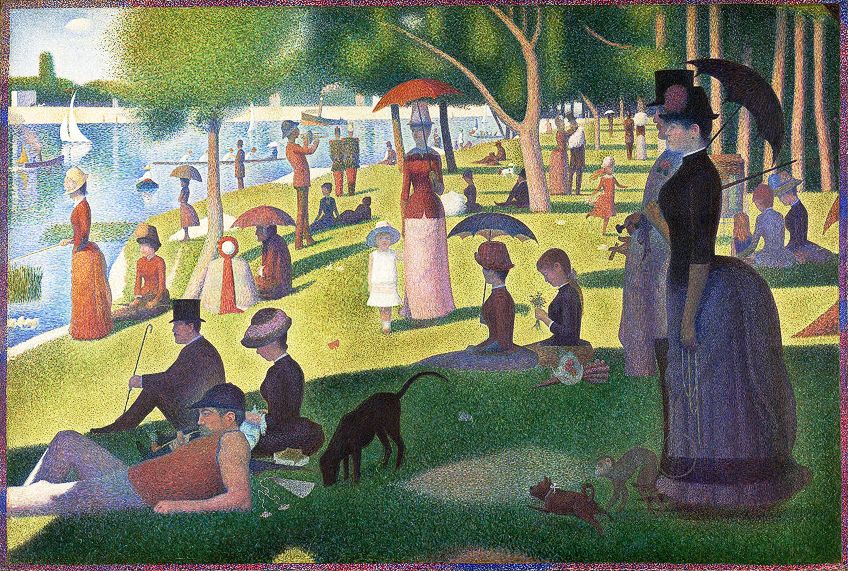 A Sun Afternoon on the Isle of La Grande Jatte(betwixt 1884 and 1886) by Georges Seurat, located in the Fine art Institute of Chicago in Chicago, United States;Georges Seurat, Public domain, via Wikimedia Commons
A Sun Afternoon on the Isle of La Grande Jatte(betwixt 1884 and 1886) by Georges Seurat, located in the Fine art Institute of Chicago in Chicago, United States;Georges Seurat, Public domain, via Wikimedia Commons
What can set the terms apart is that Harmony relates to how art elements are used in conjunction, which can be through repetition or rhythm, ultimately it is the opposite of Variety and the idea of chaos, information technology provides a feeling of "calm" or "flow".
Unity tin as well be described as relating to the entire compositional coherence, whether yous employ principles of multifariousness and harmony.
Pattern and Repetition
Patterns are fine art elements placed in repeated arrangements or sequences, whether these are from lines, colors, shapes, or others. This repetition in a composition tin can create various furnishings, for case, the idea of movement, texture, unity, or balance.
Proportion
Proportion refers to how an object's parts in a composition relate to each other due to their size or shape, for instance, a effigy'due south eye tin can be in proportion to the rest of his or her confront, it can also be also small-scale or too large.
This volition either create emphasis or different visual effects.
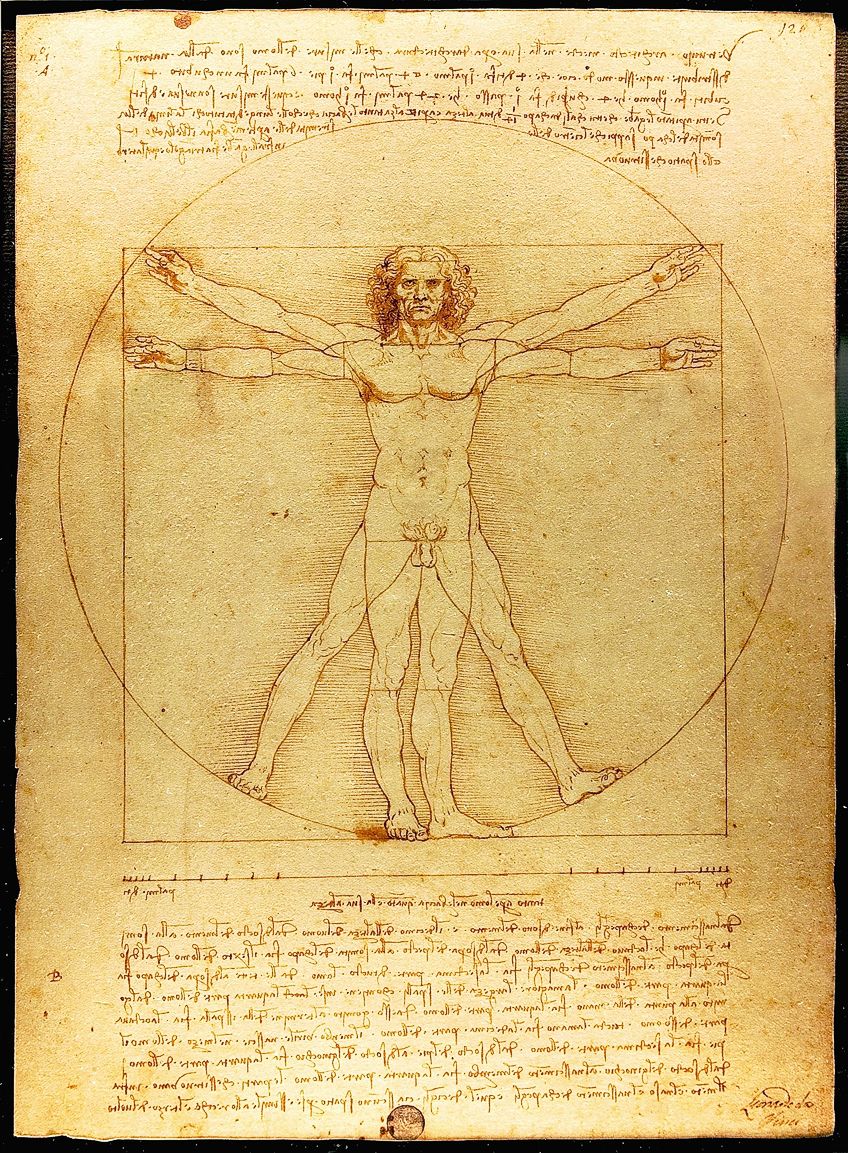 Vitruvian Man(c. 1492) by Leonardo da Vinci, located in the Gallerie dell' Accademia in Venice, Italy;Leonardo da Vinci, Public domain, via Wikimedia Commons
Vitruvian Man(c. 1492) by Leonardo da Vinci, located in the Gallerie dell' Accademia in Venice, Italy;Leonardo da Vinci, Public domain, via Wikimedia Commons
Scale
In the principles of design in art, it is important not to confuse scale with proportion. Calibration relates to the object'south size within the composition compared to all the other objects. For example, a figure standing side by side to a building, which volition exist to scale if depicted accurately in terms of how information technology would appear in real life or as some fine art sources state, "typically the size of the artwork to the viewer'southward body".
Bringing It All Together
In the article above we explore the seven principles of art, which nosotros have noted is too referred to equally the element of art. However, it is important to recall the deviation between the elements of art and principles of design, so to say.
The elements of art can be viewed every bit the colors on your palette, and the principles of blueprint tin can exist viewed equally the unlike paintbrushes. When applying each color, or fine art element, with a specific paintbrush, or art principle, you will create a compositional whole.
Oftentimes Asked Questions
What Are the Principles of Design?
At that place are several principles of design in fine art, which tin all be applied to create sure visual furnishings and feelings. These are balance, contrast/emphasis, move, pattern/repetition, proportion, rhythm, scale, unity/harmony, and multifariousness.
What Is the Deviation Between the Elements of Art and the Principles of Blueprint?
The elements of fine art and the principles of blueprint are dissimilar, simply sometimes the terms are used interchangeably. The elements of art are described as visual tools for creative compositions, and the principles of blueprint in art are all about how these elements are utilized.
What Are the Seven Principles of Art?
In that location are commonly vii elements of art. These have been described in different ways; some sources refer to them as the building blocks for creative compositions while other sources have described these as the visual tools utilized to create compositions. These are as follows: color, form, line, texture, shape, space, and value.
simonraidaured1949.blogspot.com
Source: https://artincontext.org/principles-of-art/
0 Response to "Describe Three Elements or Principles of Art Found in This Art Pie"
Postar um comentário